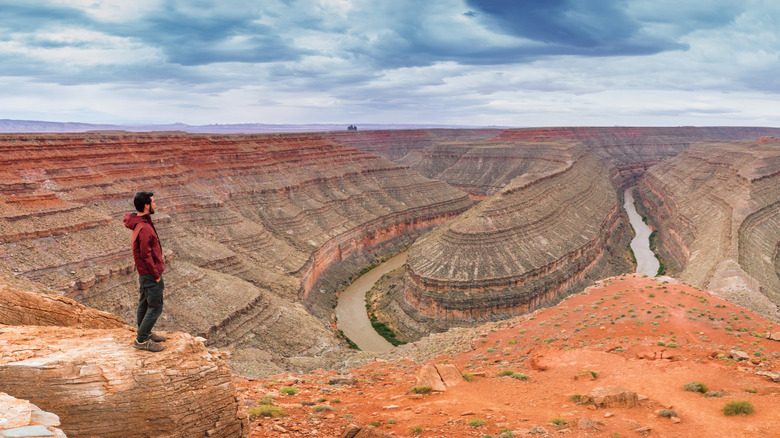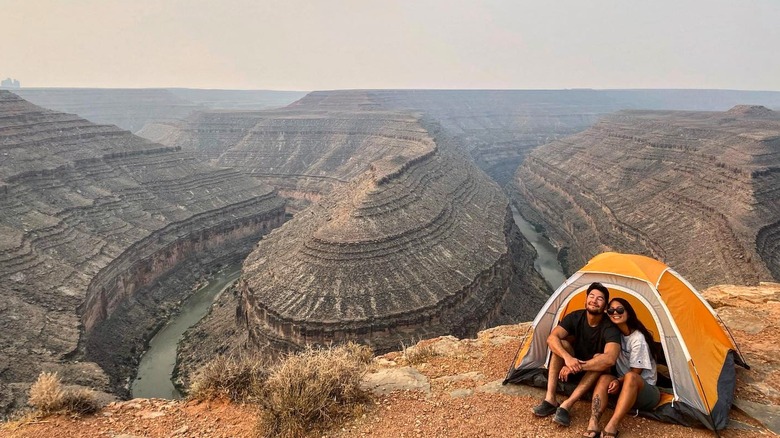One Of Utah's Most Underrated State Parks Is A Southern Stunner With Unique Clifftop Views And Camping
The mesmerizing cliffs of Horseshoe Bend, Arizona, are gorgeous, but can get pretty busy. To avoid the crowds but get a similarly breathtaking view, you can instead head to Goosenecks State Park along Utah's southern border. Situated about 350 miles south of Salt Lake City, near the town of Bluff, Goosenecks State Park wows visitors with an otherworldly landscape of dramatic cliffs and powerful water.
Once part of an ancient seabed, the 300-million-year-old rock formations at Goosenecks are composed of sandstone, shale, limestone, and siltstone. Between 15 and 20 million years ago, the San Juan River began carving its way through the desert landscape, creating S-shaped bends that resemble the curve of a goose's neck. The bends are so extreme that 5 miles of the winding San Juan river are folded into one linear mile. Over time, the powerful waters cut deeper and deeper into the land until the San Juan River became entrenched 1,000 feet below the red cliffs. Today, visitors can admire this geological wonder from a vista point overlooking the winding river and impressive gorge. Although often added as an afterthought to a Monument Valley road trip or even as a rest stop on the way further north, this tiny Utah state park definitely deserves a visit.
Camp beneath the night sky at Goosenecks State Park
Covering only 10 acres, Goosenecks State Park doesn't entice visitors with recreational opportunities like Utah's larger preserves, such as the little-known Antelope Island State Park full of wildlife, beaches, and hiking trails. You won't find designated hiking paths, a visitor's center, access to the river, or even drinking water. However, the incredible views are reason enough to journey here.
The best way to experience Goosenecks State Park is by staying overnight at one of the eight campsites. Experience the night sky in all its glory and watch the sunrise illuminate the cliffs, highlighting every shade of orange, red, and pink. Nestled on the rim of the canyon, the primitive sites feature picnic tables, vault toilets, and fire rings — although you will have to bring your own firewood. The sites are open to tents, RVs, and campers, but beware that they don't have showers, electricity hookups, or dump stations. All sites are first come, first serve, and you pay for your stay via a self-service tube.
Despite the lack of amenities, visitors love Goosenecks State Park. As one camper shared on Tripadvisor, "We were in an RV for six weeks driving around the U.S., and this is by far our favorite campground." One night is enough to experience the park's otherworldly beauty, and then you'll be ready to continue your road trip through the Southwest's most iconic red rock valleys.
Make the most of your road trip to Goosenecks State Park
Goosenecks State Park is just a few minutes off of the U.S. Highway 163, a scenic byway that extends 45 miles from the tiny town of Bluff to Monument Valley. After admiring the river's impressive beds at Goosenecks, you can continue to the Valley of the Gods and Mexican Hat. Only a 10-minute drive from the park, Mexican Hat is a must-visit red rock formation that resembles a massive sombrero. While you can admire Mexican Hat from Route 163, there's also a 0.7-mile out-and-back trail leading to the "brim" of the hat. The route is challenging (you'll be scrambling up rock) and shouldn't be attempted during the heat of midday.
Next, drive 10 minutes north of Goosenecks State Park to the monolithic rock formations at the Valley of the Gods. Each outcropping has a memorable name like Lady in the Bathtub or Seven Sailor Butte. The silhouetted sandstone formations and richly colored landscape share much in common with neighboring Monument Valley, a red rock tourist attraction that serves as an "iconic symbol of the Southwestern U.S.A." However, the Valley of the Gods is less crowded than Monument Valley, and allows you to roam to your heart's content. Because it's Bureau of Land Management (BLM) land, you don't need permits to enter, and dispersed camping is free. A word of caution: this part of Utah experiences flash flooding and is notoriously hot (over 90 degrees Fahrenheit) during the summer. Stay safe by monitoring the weather forecast and always pack extra water when exploring.


